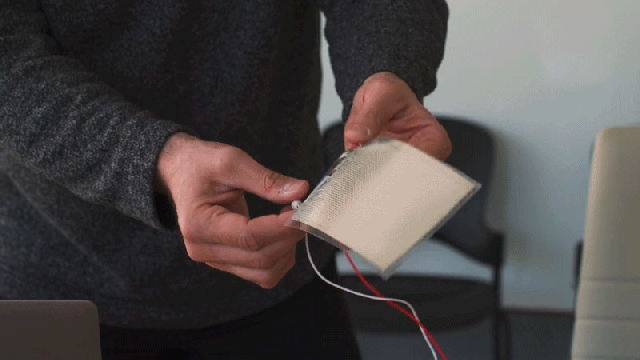You might be resigned to wearing a pair of headphones all day to block out the sounds of noisy neighbours or other distractions, but researchers at MIT have developed a paper-thin speaker that can be applied to almost any surface like wallpaper, turning objects like walls into giant noise-cancelling speakers.
Tear apart the speakers in almost any consumer device that produces sound, and you’ll find essentially the same hardware: a membrane paired with a coil of wire that produces a magnetic field (or other movement mechanism). When electricity is applied, this causes the membrane to move back and forth and push air in specific patterns, creating sound waves that reach our ears. It’s a simple formula that’s worked well for over 150 years, but one that requires a certain amount of power and a certain amount of space to work. Just look at the tower of massive speakers on either side of the stage at a concert and you’ll understand why there’s room for some improvement when it comes to speaker tech.
Researchers at MIT’s Organic and Nanostructured Electronics Laboratory have created a new kind of thin-film speaker that’s as thin and flexible as a sheet of paper, but is also able to generate clear, high-quality sound, even when bonded to a rigid surface like a wall. This is not the first time researchers have created ultra-thin lightweight speakers, but previous attempts have resulted in a film that needs to be freestanding and unencumbered to produce sound. When mounted to a rigid surface, past thin speakers’ ability to vibrate and move air is greatly reduced, which limits where and how they can be used. But MIT’s researchers have now come up with a new manufacturing process that solves that problem.
Instead of designing a thin-film speaker that requires the entire panel to vibrate, the researchers started with a sheet of lightweight PET plastic that they perforated with tiny holes using a laser. A layer of thin piezoelectric material called PVDF was then laminated to the underside of the sheet, and then the researchers subjected both layers to a vacuum and 80 degrees Celsius heat, which caused the piezoelectric layer to bulge and push through the laser-cut holes in the top layer. This created a series of tiny domes that are able to pulse and vibrate when an electric current is applied, regardless of whether or not the panel is bonded to a rigid surface. The researchers also added a few extra layers of the durable PET plastic to create a spacer to ensure that the domes can vibrate freely, and to protect them from abrasion damage.
The domes are just “one-sixth the thickness of a human hair” in height and move a mere half micron up and down when they vibrate. Thousands are needed to produce audible sounds, but the researchers also discovered that changing the size of the laser-cut holes, which also alters the size of the domes produced, allows the sound produced by the thin-film panel to be tuned to be louder. Because the domes have such minute movement, just 100 milliwatts of electricity were needed to power a single square metre of the material, compared to more than a full watt of electricity needed to power a standard speaker to create a comparable level of sound pressure.
The applications for the thin-film speaker material are endless. In addition to being applied to interiors like office walls or even the inside of an aeroplane to cancel out unwanted noises, an entire car could be wrapped in a speaker, making it easier to alert pedestrians that an otherwise silent electric vehicle was approaching. The researchers believe the technology could even be used for ultrasonic imaging, tracking the movements of people in a given space, or even as a futuristic display technology by covering all those tiny domes in reflective surfaces, similar to how Texas Instrument’s DLP technology works. But the one thing the researchers can’t foresee is when we might actually see this technology hit the market.
